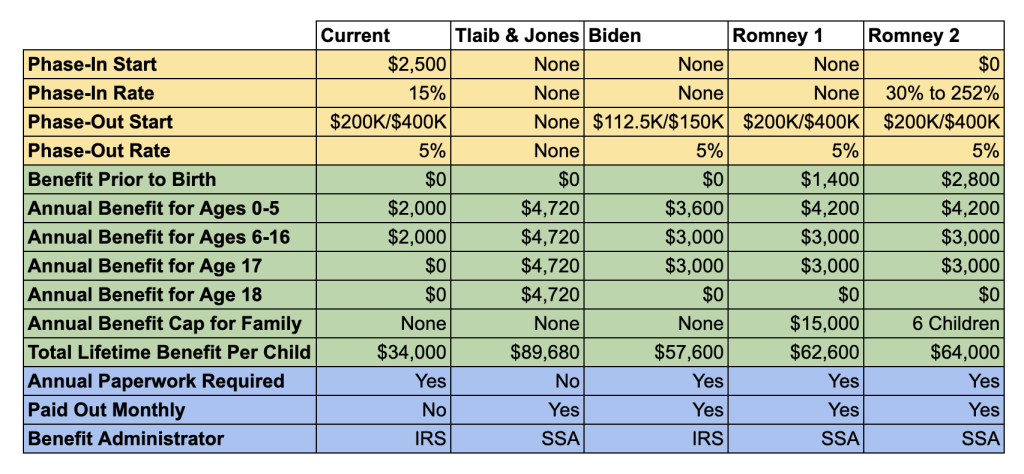When Democrats proposed enacting a one-year fully refundable child tax credit last year, Mitt Romney released a counter-proposal to create a permanent child allowance benefit administered by the Social Security Administration. The Romney proposal was better than the Democratic proposal and it was clearly a mistake, both at the time and in hindsight, not to take him up on the offer.
Yesterday, Romney released a second version of his proposal. Unlike the first version, the new version no longer extends benefits to the poorest children. Specifically, children in families earning less than $10,000 per year will be ineligible for the full benefit of the program, with the poorest children receiving nothing at all.
The following table summarizes some of the key details of the various child benefit proposals circulating at the moment.

In some respects, the new Romney proposal just reflects what was, until recently, the bipartisan consensus on child benefits. According to that consensus, it is important to ensure that children with low-earning parents live miserable, unstable, and destitute lives characterized by hunger, homelessness, and social alienation so as to provide an extra incentive for their parents to increase their earnings.
In the same way that a kidnapper might hold a child at gunpoint to extract a ransom from their parents, the general view of elected representatives has been that it is good policy to credibly threaten children with severe impoverishment on the hope that it will convince their parents to contribute more work hours to the food service and retail sectors.
Nevermind the insane cruelty of this approach, the fact that people do not have control over whether employers hire them or how many hours they are scheduled for, the fact that poor-exclusive benefit designs have not been shown to increase employment, the fact that other countries with poor-inclusive child benefits have perfectly fine employment rates that even exceed our own, or that poverty stunts child development in ways that clearly reduce the adult employment of impoverished children. The hostage-taking common sense has simply been too strong to overcome, in America.
But in other respects, the new Romney proposal is uniquely cowardly and ridiculous. Usually, the poor just get excluded from this behind closed doors and everyone involved decides not to talk about it too much since it is kind of a bummer. Here, Romney presented a perfectly fine policy and then came out with a second version of it that is the same thing as the first one except with the poor carved out. And all of this was done right out in public for everyone to see!
What’s even more disgusting about the whole thing is that the apparent reason Romney implemented this change was as an olive branch to pro-life Republicans and Senator Steve Daines, the head of the pro-life caucus, in particular. In the press release for the new proposal, Romney included three quotes of support, all from pro-life conservative organizations. So, this is how he is trying to slant the thing now.
But what does it tell us about Steve Daines and these pro-life organizations more generally that, to get their support for Romney’s child benefit plan, Romney needed to modify it so as to ensure that the most desperate families with kids are left out? What exactly is the pro-life rationale for providing benefits to everyone except the poorest kids? And if there isn’t any pro-life rationale for it, then why didn’t Steve Daines and National Right to Life endorse the first Romney plan? This whole pro-life side plot is completely ridiculous and everyone involved in it should feel embarrassed by it.
In addition to being really cruel, the exclusion of poor kids in the new proposal is also likely to create some serious administrative problems. In Romney’s first proposal, all kids would receive the $250/$350 per month and then parents who wound up with an annual income above $200k (for singles) and $400k (for marrieds) would effectively pay a special 5% income tax to the IRS for income beyond those thresholds until the benefit they received was clawed back. This was not a perfect design, but it was workable because it only applied to a small number of rich tax units with incomes beyond the $200k/$400k phaseout threshold.
But in the new plan, this overpayment-then-clawback scenario would apply, not just to families with incomes beyond $200k and $400k, but also to families with income below $10k. If the Social Security Administration sends every kid $250/$350 per month, this would result in families who wind up with less than $10k of income receiving benefit overpayments. If, as the proposal still states, “any overpayments or underpayments would be reconciled through the IRS after filing year-end taxes,” then these families would owe a tax debt at the end of the year that they clearly cannot afford to pay.
There are various ways to try to patch up this overpayment problem. You could eliminate the monthly disbursal. You could try to alter the amount of the monthly payment based on guessing someone’s likely income for the year. You could base eligibility on prior-year income instead of current-year income. But these either don’t fully fix the problem or create new problems of their own.
In closing out this piece, I would be remiss to not point out that there is a perfect child benefit proposal out on the table right now: the End Child Poverty Act introduced by Members Jones and Tlaib. The Tlaib/Jones proposal directs the Social Security Administration to provide each child a monthly benefit equal to the difference between the one-person poverty line and the two-person poverty line. There are no phase-ins, no phase-outs, and for that reason, no need for any paperwork beyond initially enrolling in the program at birth at the same time that children are already signed up for their Social Security number. That is what we should be aiming for.

